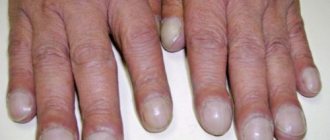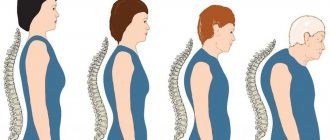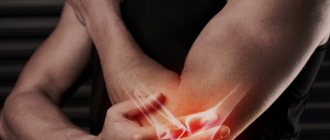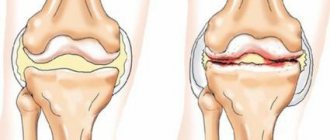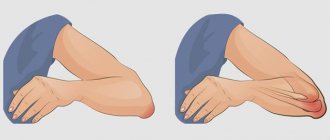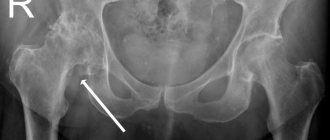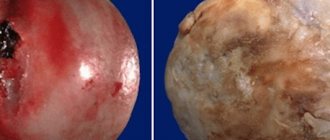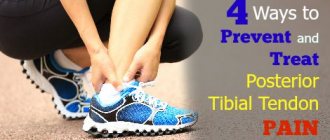Classification of pathology
The disease is divided into two forms - primary and secondary:
- Primary. Occurs due to spinal injury. In this case, the cause may be displacement, severe bruise, or crack. Sometimes it can appear a long time immediately after the injury.
- Secondary. In such a situation, pain syndrome is caused by third-party diseases, both proctological and urological. This type of disease is divided into two types. The first is pain due to problems with the rectum; this case is called “proctalgia”. The second is the concentration of pain in the rectum. It can have a diffuse localization, spreading to the genitals, abdomen, buttocks. This case is called "anorectal pain."
Treatment
Treatment of coccydynia is carried out based on the identified causes of the disease. Experts prefer a conservative method of treatment, which helps in the vast majority of cases. The general principles are to prescribe comprehensive treatment, which includes physiotherapy and massage treatments. Ultrasound technologies are widely used in combination with glucocorticoid therapy, anesthesia and electrotherapy. The latter technique is based on inserting an electrode into the rectal space. Massages, underwater traction, and paraffin baths are good for muscle spasms. The goal of the procedures is to straighten or return the tailbone to its normal physiological state. Diseases accompanied by pain require the use of analgesics.
Causes of pathology
Symptoms of coccydynia occur against the background of numerous disorders in the body and poor lifestyle. If a person sits a lot and moves little during the working day, he is at risk.
Scars in the anus that appear due to injury or surgery lead to the need for treatment of coccydynia. The secondary form also develops against the background of numerous types of diseases - prostatitis, hemorrhoids, paraproctitis.
Let's look at equally common causes of pain below.
Injuries
Traumatic injury is the most common cause of the development of the primary form of the disease. It may appear if you inadvertently fell on your back or the tailbone itself. In this case, a dislocation, crack or displacement appears.
Often a person gets injured and forgets about it for a while. However, even a slight change in the position of the bone makes itself felt over time - pain can come suddenly and make it impossible to move normally.
Neuritis, myositis
The answer to the question of how to treat coccydynia may lie in determining the causes of inflammation of the nerves - it is called neuritis. Often, inflammatory processes can appear in the muscles - they are called myositis.
A detailed diagnosis of the body is required, because such ailments develop against the background of other, even more serious diseases of the musculoskeletal system.
Constipation
If you do not have a bowel movement for several days or spend a lot of time on the toilet, pushing frequently, pain in the tailbone may also develop.
Weakening of ligaments and muscles in the perineal area
This reason is typical for representatives of the older age group. Sometimes it can be observed against the background of injuries, as well as working with too much stress. Former athletes are at risk.
Prevention of coccydynia of the coccyx
Of course, none of us are immune from this disease. However, following a number of simple rules will help avoid pain in the tailbone.
Avoid physical strain and injury. Shoes with stable soles will protect you from falls, especially in icy conditions. Be careful on wet, smooth steps - this is where falls on your tailbone often occur.
You should not take risks for the sake of dubious success during sports: descending a steep mountain on skis or on a bicycle often leads to falls and bruises of the tailbone. It is not recommended to carry heavy objects, especially for older people, as there is a high risk of losing balance and falling.
If you have a sedentary job, be sure to do a warm-up once an hour - get up and walk around the room or along the corridor. This will avoid congestion in the pelvic area. Use soft, springy chairs and place pillows (available in pharmacies) under your pelvis.
However, if coccydynia of the coccyx is diagnosed, the disease cannot be neglected - it is insidious in that the pain can recede, and then arise with renewed vigor. At the Health Plus clinic you will be provided with timely, qualified assistance. The latest equipment and advanced treatment methods using shockwave therapy can give high results. Your health is in your hands, so don’t miss it!
Symptoms of coccydynia
The symptoms and treatment of coccydynia in men and women are largely similar. Let's name the most common signs of this disease.
Pain syndrome
Pain with this disease can be of a different nature. In some patients it occurs constantly and can last for several years. Some patients even get used to it and live with these symptoms for years. For other people, pain occurs periodically and is provoked by various external factors - from heavy loads to long periods of sitting in one position. Often stimulates discomfort and emptying of the rectum.
Change in gait
To answer the question of what it is, coccydynia, we need to consider poor posture. It is painful for a person to move, so he shifts from one foot to another. He tries to walk as carefully as possible so as not to put unnecessary strain on the tailbone.
Irritable bowel syndrome
This designation groups a whole range of symptoms associated with improper functioning of the rectum. This may manifest itself as abdominal discomfort and constipation. Sometimes people with these symptoms may become depressed or irritable for no apparent reason.
Localization of discomfort
Localization can be different, most often it is concentrated directly next to the tailbone, but it can extend to the rectum and perineum. Many patients complain that their stomach begins to hurt. Unpleasant sensations also affect the genitals. Any pressure on the affected area leads to increased pain.
Symptoms and diagnosis of coccydynia of the coccyx
This disease manifests itself quite typically. Let us list the main signs of diagnosed coccydynia and the most common complaints of patients:
- pain in the coccyx area during prolonged sitting;
- a sharp increase in pain in the tailbone when standing up and after physical activity;
- pain during bowel movements;
- stiffness of movements of the lower extremities;
- change in gait: a person suffering from coccydynia walks slowly, waddling slightly.
During an initial examination, an experienced therapist can recognize this disease by analyzing the patient’s complaints and asking him about possible injuries, as well as lifestyle. However, often gynecological, urological, and proctological diseases can contribute to the appearance of pain in the coccyx area. To rule out this cause of pain, your doctor may prescribe an ultrasound examination. If coccygonia of the coccyx occurs as a result of injury, an X-ray examination or computed tomography is prescribed to clarify the clinical picture. These studies make it possible to identify post-traumatic changes in the coccyx.
Diagnosis of pathology
A neurologist should tell you about the symptoms and treatment of coccydynia. He also prescribes the necessary examinations. Among them:
- Studying the patient's medical history, as well as carefully recording his current complaints. The specialist will clarify whether you have a hereditary predisposition to various types of diseases and ask questions about your lifestyle.
- Inspection. A neurologist
will need to palpate the tailbone, and also clarify the presence of diseases such as radiculitis, fissures in the anus, hemorrhoids, prostatitis, and urethritis. - Examination using special instruments. Ultrasound, CT, radiography, colonoscopy are performed.
To specify the symptoms and treatment of coccydynia, you will also need to perform a laboratory examination. A clinical and biochemical blood test is performed, the condition of the urine is checked, and a coprogram is performed.
Prevention
The first thing you can do to avoid coccydynia and many other diseases is to visit your doctor regularly. A specialist can promptly identify concomitant diseases and prevent the development of coccyx pathology. If you have already discovered signs of coccydynia, you should immediately seek professional help. In the early stages, the disease is treated much easier and faster. In addition, it is worth taking care of the presence of comfortable orthopedic furniture in the workplace. Don't sit with your legs tucked to your chest, try to take the pressure off your tailbone. If it is not possible to purchase orthopedic furniture, try placing a small pillow - it is both more comfortable and safer. Last but not least, try to avoid injuries to the tailbone and pelvic organs. If this fails, consult a doctor immediately.
Treatment of coccydynia
Let's consider how to treat coccyx disease coccydynia. The treatment method will depend on the patient’s sensations, the nature of the pain, and the nature of the development of the pathology.
Drug therapy
To alleviate paroxysmal and constant pain, local anesthetics, non-steroidal anti-inflammatory drugs, muscle relaxants and tranquilizers are used.
Physiotherapy
Often the physical therapy method helps to alleviate the sensations. It is aimed at relaxing the muscles, and also allows you to tidy up the ligaments and muscles.
Physiotherapeutic procedures
Patients are prescribed massage, darsonvalization and laser therapy.
Traditional treatment
Traditional methods are aimed at reducing irritation, as well as relieving pain. Herbal ointments and chamomile baths are often used.
Preparations for blockade for pain in the tailbone
To reduce pain, drugs that have analgesic and anti-inflammatory effects are injected. Depending on the indications, they can do a monocomponent (one drug is used) or a multicomponent (mixture of several drugs) blockade.
A long, thin needle is used to administer medications.
In medicine, both well-known analgesics and new generation drugs are used:
- Novocaine. It is the safest local anesthetic because it has minimal side effects. Reduces pain, relieves spasms, improves trophism of nervous tissue.
- Lidocaine. The effect of injections of this anesthetic is longer than that of Novocaine. The pain subsides within a few minutes after the injection.
- Bupivacaine. Many times more powerful than Novacain. Although after the injection the pain does not go away immediately, but gradually, the effect remains for a long time.
- Diprospan. This is the newest analgesic drug used for coccydynia. Blockades with Diprospan are done at the SmartMed clinic. The analgesic and anti-inflammatory effect is quick and long-lasting. Just 1-2 injections of Diprospan are enough to get rid of chronic pain syndrome. It is effective against destructive-dystrophic diseases of the spine and has fewer complications compared to its analogues.
Together with Diprospan and other analgesics, corticosteroid drugs that have an anti-inflammatory effect can be used. These include Hydrocortisone, Dexamethasone.
The choice of medication is at the discretion of the doctor. The doctor chooses the safest and most effective drug for the patient.
Diagnostics
To establish a reliable diagnosis, a series of examinations are carried out to identify the cause of the pain. At the Yusupov Hospital, differential diagnostics is performed with other pathologies that have similar manifestations. Because the more accurately the cause of the disease is determined, the more correct the treatment will be.
Diagnosis of coccydynia at the Yusupov Hospital will include the following measures:
- General and clinical blood test;
- Analysis of urine;
- Coprogram;
- Colonoscopy;
- Radiography;
- CT scan.
These studies will allow us to assess the extent of tissue damage and determine the pathological focus. For diagnostics, the Yusupov Hospital uses modern equipment, with which it is possible to obtain the most reliable results.
The initial examination of the patient is performed by a coloproctologist, who determines the treatment plan. Additionally, consultation with a neurologist, andrologist, traumatologist and other specialists may be required.
Causes of coccydynia
The causes of coccygodnia may affect the pathology of therapeutic and surgical profiles. These include:
- injuries to the coccygeal spine after a blow to the back, a fall;
- microtraumas, neuritis, myositis, sprains due to prolonged sitting, driving on bad roads, hypothermia, prolonged straining with constipation;
- chronic inflammatory processes in the nerve fibers innervating the coccyx;
- diseases of the anus and rectum (hemorrhoids, paraproctitis);
- diseases of the genitourinary system;
- cicatricial changes in the perineum after surgery;
- weakening of muscles and ligaments in old age;
- diseases of the pelvic organs (inflammation of the prostate gland, urethra);
- stress.
Coccydynia according to ICD-10
The International Classification of Diseases, 10th revision, is used by doctors to convert the clinical formulation of a disease into a code that provides convenient storage of data. According to ICD-10, coccydynia refers to sacrococcygeal degenerative processes that are not classified in other categories and has the code M53.3.
Patients visiting the Yusupov Hospital receive medical care that meets international standards. Coloproctologists regularly study world experience in treating this disease, innovative methods of its treatment and engage in scientific activities, the results of which are presented at various conferences and symposia.
One of the main advantages of the Yusupov Hospital is that the patient can receive a complex of diagnostic, therapeutic, and rehabilitation measures in one place. Coccydynia in women, the symptoms of which may be mistaken by the patient for manifestations of other diseases, requires long-term treatment. Patients turn to coloproctologists with varying degrees of severity of coccydynia; experienced specialists are ready to provide medical assistance even in severe cases.

